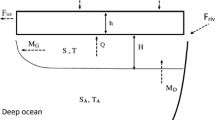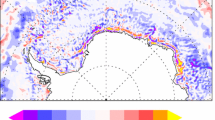Abstract
A crucial controlling factor on the stability of the two-layered water column in the Weddell Sea is its sea ice cover, which acts through a negative feedback mechanism (NFM) due to the thermal barrier at the mixed layer base. The present study revisits the problem of how the NFM affects the stability and overturning of the water column using a fine-resolution nonhydrostatic model to run experiments employing various background mixing coefficients (viscosity \(\nu\) and diffusivity \(\kappa\)) and Earth rotation (Coriolis parameter f) with and without the sea ice cover. In the ice-free case without the NFM, destabilization and overturning of the water column are accelerated by lower \(\nu\) (\(\kappa\)) and \(f=0\) , since convection is enhanced in the mixed layer. Vigorous convection increases the upward salt flux from the deep layer and densifies the mixed layer against the concurrent upward heat flux. In the ice-covered case with the NFM, to the contrary, the destabilization and overturning are decelerated by lower \(\nu\) (\(\kappa\)) and \(f=0\). The upward heat flux due to mixed layer convection delays destabilization by reducing ice formation through the NFM. On the other hand, lower \(\kappa\) decelerates the overturning, suppressing cabbeling instability at the mixed layer base. As a result, the entire process of destabilization and overturning needs more than two months at the maximum. Additional experiments, together with observational data, suggest that such a slow process may have occurred in the Weddell Sea.










Similar content being viewed by others
References
Aagaard K, Coachman L, Carmack E (1981) On the halocline of the Arctic Ocean. Deep Sea Res Part A 28(6):529545
Akitomo K (2011) Two types of thermobaric deep convection possible in the Greenland Sea. J Geophys Res 116:C08012. https://doi.org/10.1029/2010JC006635
Akitomo K (1999a) Open-ocean deep convection due to thermobaricity, 1. Scaling argument. J Geophys Res 104:5225–5234
Akitomo K (1999b) Open-ocean deep convection due to thermobaricity, 2. Numerical experiments. J Geophys Res 104:5235–5249
Akitomo K, Awaji T, Imasato N (1995) Open-ocean deep convection in the Weddell Sea: two-dimensional numerical experiments with a nonhydrostatic model. Deep-Sea Res I 42:53–73
Boyer TP, Antonov JI, Baranova OK, Coleman C, Garcia HE, Grodsky A, Johnson DR, Locarnini RA, Mishonov AV, OBrien TD, Paver CR, Reagan JR, Seidov D, Smolyar IV, Zweng MM (2013) World Ocean Database 2013. Sydney Levitus, Ed., Alexey Mishonov, Technical Ed., NOAA Atlas NESDIS 72, 209
Cavalieri JD, Martin S (1994) The contribution of Alaskan, Siberian and Canadian coastal polynyas to the cold halocline layer of the Arctic Ocean. J Geophys Res 99:18343–18362
Carsey FD (1980) Microwave observation of the Weddell Polynya. Mon Weather Rev 108:2032–2044
Chandrasekhar S (1961) Hydrodynamic and hydromagnetic stability. Oxford University Press, 654
Cheon WG, Lee SK, Gordon AL, Liu Y, Cho CB, Park JJ (2015) Replicating the 1970s Weddell Polynya using a coupled ocean-sea ice model with reanalysis surface flux fields. Geophys Res Lett 42:54115418. https://doi.org/10.1002/2015GL064364
de Lavergne C, Palter JB, Galbraith ED, Bernardello R, Marinov I (2014) Cessation of deep convection in the open Southern Ocean under anthropogenic climate change. Nat Clim Change 4:278–282
Foster TD, Carmack EC (1976) Temperature and salinity structure in the Weddell Sea. J Phys Oceanogr 6:36–44
Garwood RW, Isakari SM, Gallacher PC (1994) Thermobaric convection. In: Johannessen OM, et al (eds) The polar oceans and their role in shaping the global environment: the nansen centennial volume. Geophys Monogr Ser, Vol. 85, AGU, Washington DC, pp 199–209
Gordon A, Visbeck M, Comiso JC (2007) A possible link between the Weddell Polynya and the Southern Annular Mode. J Clim 20:2558–2571
Gordon AL (1991) Two stable modes of Southern Ocean winter stratification. In: Chu PC, Gascard JC (eds) Deep convection and deep water formation in the oceans. Elsevier, Amsterdam, pp 17–35
Gordon AL, Huber BA (1990) Southern Ocean winter mixed layer. J Geophys Res 95:11655–11672
Gordon AL (1981) Seasonality of Southern Ocean sea-ice. J Geophys Res 86:4193–4197
Harcourt RR (2005) Thermobaric cabbeling over Maud Rise: theory and large eddy simulation. Progr Oceanogr 67:186–244
Heuzé C, Heywood KJ, Stevens DP, Ridley JK (2013) Southern Ocean bottom water characteristics in CMIP5 models. Geophys Res Lett 40:14091414. https://doi.org/10.1002/grl.50287
Hirabara M, Tsujino H, Nakano H, Yamanaka G (2012) Formation mechanism of the Weddell Sea Polynya and the impact on the global abyssal ocean. J Oceanogr 68:771796. https://doi.org/10.1007/s10872-012-0139-3
Killworth PD (1983) Deep convection in the world ocean. Rev Geophys Space Phys 21:1–26
Killworth PD (1979) On ’chimney’ formations in the ocean. J Phys Oceanogr 9:531–554
Martinson DG (1990) Evolution of the southern ocean winter mixed layer and sea ice: open ocean deepwater formation and ventilation. J Geophys Res 95:11641–11654
Maxworthy T, Narimousa S (1994) Unsteady, turbulent convection into a homogeneous, rotating fluid, with oceanographic applications. J Phys Oceanogr 24:865–887
Morawitz WML, Sutton PJ, Worcester PF, Cornuelle BD, Lynch JF, Pawlowicz R (1996) Three-dimensional observations of a deep convective chimney in the Greenland Sea during winter 1988/1989. J Phys Oceanogr 26:2316–2343
Motoi T, Ono N, Wakatsuchi M (1987) A mechanism for the formation of the Weddell Polynya in 1974. J Phys Oceanogr 17:2241–2247
Muench RD (1991) Relict convective features in the Weddell Sea. In: Chu PC, Gascard JC (eds) Deep convection and deep water formation in the oceans. Elsevier, Amsterdam, pp 53–67
Muench RD, Fernando HJS, Stegen GR (1990) Temperature and salinity staircases in the northwestern Weddell Sea. J Phys Oceanogr 20:295–306
Ronski S, Budéus G (2005) Time series of winter convection in the Greenland Sea. J Geophys Res 110:C04015. https://doi.org/10.1029/2004JC002318
Shaw W, Stanton T (2014) Dynamic and double-diffusive instabilities in a weak pycnocline: part I: observations of heat flux and diffusivity in the vicinity of Maud Rise, Weddell Sea. J Phys Oceanogr 44:1973–1991. https://doi.org/10.1175/JPO-D-13-042.1
Sirevaag A, McPhee MG, Morison JH, Shaw WJ, Stanton TP (2010) Wintertime mixed layer measurements at Maud Rise, Weddell Sea. J Geophys Res 115:C02009. https://doi.org/10.1029/2008JC00514
Su Z, Ingersoll AP, Stewart AL, Thompson AF (2016a) Ocean convective available potential energy. Part I: Concept and Calculation. J Phys Oceanogr. 46:1081–1096. 10.1175/JPO-D-14-0155.1
Su Z, Ingersoll AP, Stewart AL, Thompson AF (2016b) Ocean convective available potential energy. Part II: energetics of thermobaric convection and thermobaric cabbeling. J Phys Oceanogr 46:1097–1115. https://doi.org/10.1175/JPO-D-14-0156.1
Timmermann R, Beckmann A (2004) Parameterization of vertical mixing in the Weddell Sea. Ocean Modell 6:83–100
Tsujino H, Hirabara M, Nakano H, Yasuda T, Motoi T, Yamanaka G (2011) Simulating present climate of the global ocean-ice system using the Meteorological Research Institute Community Ocean Model (MRI.COM): simulation characteristics and variability in the Pacific sector. J Oceanogr:67, 449-479, https://doi.org/10.1007/s10872-011-0050-3.
Yashayaev I, Loder JW (2009) Enhanced production of Labrador Sea Water in 2008. Geophys Res Lett 36:L01606. https://doi.org/10.1029/2008GL036162
Zanowski H, Hallberg R, Sarmiento JL (2015) Abyssal Ocean warming and salinification after Weddell Polynyas in the GFDL CM2G coupled climate model. J Phys Oceanogr 45:2755–2772
Acknowledgements
Numerical calculation has been carried out on the supercomputer of ACCMS, Kyoto University. This study was partly supported by the Grant-in-Aid for Scientific Research No.24340112 in the period for 2012 through 2014 from the Ministry of Education, Culture, Sports, Science, and Technology, Japan.
Author information
Authors and Affiliations
Corresponding author
Rights and permissions
About this article
Cite this article
Akitomo, K. Stability and slow overturning of the water column in the Weddell Sea under a sea ice cover. J Oceanogr 75, 95–109 (2019). https://doi.org/10.1007/s10872-018-0488-7
Received:
Revised:
Accepted:
Published:
Issue Date:
DOI: https://doi.org/10.1007/s10872-018-0488-7




